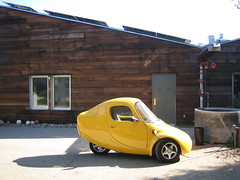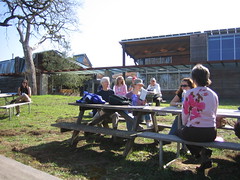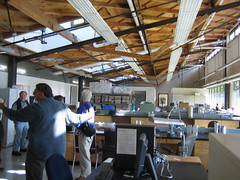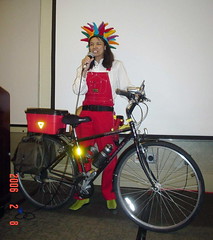Sparrow Days Are Here Again
The nine month absence of our electric car completely blew away any pretense that this was a viable transportation solution, yet when the Sparrow returned, all was right with the world again. Ed, my mechanic, was as happy as I was that he wouldn't be having to answer my anxious phonecalls. It had been a long journey even for a Sparrow repair and in the end he had had to call a woman in to finish the job. But not just any woman. Claire Bell had worked for the original Corbin factory and knew how the replacement controller was supposed to be wired.
The controller comes between the battery pack and the motor and through the accelerator, controls how much juice is applied to the motor. The controller I needed wasn't made anymore, so a different controller was put into service with a little cutting and welding to make it fit. Oh and there was a missing bracket Ed had to go to another state to find, asking around at an EV rally for the spare part. Now, $1500 later, our Sparrow is perkier than ever. The new controller gives more juice to the motor and uses the battery pack more efficiently, too.
When people buy new cars they like to read reviews on how great their car is. It's a chaser for buyer's remorse. For me I'm doing the same when I go to a talk on global warming. So the first place I drove my yellow friend to was a brown bag lecture at the County Center in Redwood City where I was pleased to see a colleague, our Feng Shui expert, Linda Lenore. (Feng Shui being more than just about what to put in your wealth corner, is, first, about one's immediate environment and though it hadn't occurred to me, this naturally leads to being green).
A scientist from Foothill College, Robert Cormia, was speaking on future levels of CO 2. He was part of a mission, he explained, prompted by the recent gag order on NASA scientist James Hansen, a global warming physicist. The Bush administration was attempting to prevent him from speaking in public, fearing that once the public gets wind of this information, the government will have to actually do something. Thus hundreds of other scientists were taking up the call and going out into the community with the same charts and graphs to explain the science to lay people like us. Local government officials were encouraging him, because they couldn't back global warming policies until they had their constituents behind them. And I thought it was the other way around.
We, in the room, had no doubt that global warming was the most significant environmental challenge of humankind. The planet were already one degree warmer than 50 years ago, but as Robert explained, pumping CO 2 emissions into the atmosphere was like putting money in the bank. What CO 2 we emitted, now, would be waiting to come out later like compound interest. We still had another degree to go due to the CO 2 we had already emitted. If we were more math literate we would get it, he said, as if we could do the calculations ourselves and presto have our climate change model to show to people.
There were some random facts we could tuck into our pocket. The north pole ice cover, for instance, had been shrinking by 10% every decade which would mean less snow to reflect back the sun's rays thus increasing the warming effect. The thermoline cycle, which controls the ocean currents that keep Europe warm, had slowed by 30%. Yes, I had heard Europe had been freezing this winter. Now Antarctica ice was cracking much sooner than scientists had predicted. It's that "sooner than predicted" part that gets me.
With facts like that it felt even more compelling to be on the solution side of the equation because if we didn't face the music now the situation would be catastrophic later. So when Catherine and I shoehorned ourselves into the Sparrow for the drive to the Sun Field Station on Jasper Ridge, we were given the royal treatment.
"The electric car is here," announced the curator of the station, as we pulled up. Our arrival was expected since I had called ahead asking for a place to plug-in. Catherine, who is shy, slipped away from the scene, leaving me to answer questions and have my picture taken with the Sparrow. We were to spend the day there with our classmates from our leadership program. Each month, Acterra, the sponsoring organization of the course, scheduled our daylong class at a different location.
I had particularly looked forward to visiting the Sun Station because, not only was it closed to the public, but it was an example of net zero carbon emissions planning. That is, the building was designed to produce all its own energy thus emitting no carbons during its use. This was accomplished with a passive solar design, solar heated water, and solar panels. The station was also built using redwood salvaged from two nearby buildings that were going to be demolished, some old bricks someone donated and other thoughtful, resource reducing features. The effect was of an austere, but pleasant space; beautiful in the way it nestled into the surrounding grasslands and oak trees.
So beautiful that its use has expanded, thus upsetting the carefully budgeted energy production of the solar panels. Graduate students liked to hang out there burning the midnight oil and the University liked to hold parties there requiring the use of banks of lights to illuminate the picnic tables outside. And groups like us, too, added to the use. Plus they hadn't counted on the electric cars they later purchased. (They had two golf cart type vehicles). I reached into my pocket to offer some spare change to offset the 5 kilowatts the Sparrow would use. Everyone laughed. (For off peak use at 8 cents per kilowatt it would have come to 40 cents).
"Each watt of power produced onsite is equivalent to 10 watts of power produced at a power plant," our guide told us. Why? Because it takes 9 watts of power to transmit each watt over those miles of transmission lines. Catherine and I looked at each other, pleased that our solar panels turned out to be worth so much more in generating power. Nine times the energy lost to transportation! (This calculation seems to be controversial; Philippe referred me to Amory Lovins and the Rocky Mountain Institute.) It reminded me of the 1500 miles that the average food item travels to get to our stores and the massive amounts of freight travel needed to get products to us from Asia. Travel expense seems to be the biggest factor in the globalized economy. What an astonishing waste. How come nobody ever tells us about that? a colleague asked. Nobody tells us nothin'.
Is information being kept from us? we wanted to know. We had our chance to ask these questions of our first speaker, Paul Rogers, a reporter from the San Jose Mercury. His beat was the environment and we believed his sincerity in trying to get out important news on environmental issues, but when asked why there wasn't more coverage of global warming he pitched the question back to us. What did global warming look like? he asked. When is it breaking news? How are the TV cameras supposed to show us? When there's an oil spill you can be sure every station is there taking pictures of oil-soaked birds, he pointed out, but polar bears starving? That was not an event. Now Katrina, that was an event and probably the best thing to happen for the issue of global warming, he said.
I couldn't wait for hurricane season. I, perversely, couldn't wait to watch as all the rebuilding efforts are wiped out in another series of intensified storms. But then what? How did society move to change?
We had a chance to find out as we all filed out into the sun and took up positions in a role-playing exercise called the Innovation Diffusion Game. In this model of cultural change there is an 'innovator' with a new idea who is helped by 'change agents' who promote the idea to 'early adopters'. When enough people adopt the idea to create a critical mass of just 5% to 15% of the population, the idea has a life of its own and is carried by momentum. It becomes something everyone is talking about.
We were to pretend we were driving our gas-guzzlers into town while the innovator was to attempt to talk up a better way. We drew our roles out of a hat. Ironically I pulled the role of a mainstreamer, the average Joe, unconscious mostly and unlikely to adopt anything new until it was fully in the eye of the public. I took to the role with gusto, touting the virtues of my fully equipped Land Rover. Soon I found the other mainstreamers and we celebrated our majority status. It felt good to be mainstream, restful even, to just go about my business without thinking too much about things. Life was jolly and I had lots of friends. Sure there were some oddballs who came to talk to me about driving a smaller car, but I always had my reasons not too.
After some time, my fellow mainstreamers seemed to have disappeared and I was left with the stubborn 'reactionary'. Meanwhile there was this huge group hanging around the innovator, talking to him and asking questions about the "plug-in hybrid". (As myself, I was tickled that the plug-in hybrid was the innovation. Indeed a New York Times article had just come out, unequivocally touting it as the one viable solution within reach. And the San Francisco city council, along with many other cities, had just unanimously voted to buy the plug-in hybrid for the city's fleet, to show automakers there was a market for such a car.)
The game came to a close. We had done it. We had created doubt in the mind of those who thought everything was just fine as it was, while the innovator's idea was being talked up like it was the next big thing. Having played the role of a mainstreamer, I could see the importance of ideas being bounced around even though I might not participate in the conversation. Perhaps the most important lesson of this game was to show that we were all just people and by having relationships with those not necessarily in lockstep with us, we could introduce something new or be exposed to something new. (We were connectors, just as the global warming scientist had mentioned. Don't waste time on skeptics, he had said. Talk to the connectors who will spread the word to their different groups.)
I was high from the day. I could see that the future would bring change whether people were ready for it or not, but there would be enough of us working away on stuff behind the scenes. Enough so that as soon as the ax of need and desperation fell, we would be there to move things along, grabbing at all the low hanging fruit that had been neglected before. All our change agents, transformers, iconoclasts and innovators would suddenly be center stage. And what a show the world would see then. Such was the Pollyannarizing effect of having the Sparrow back.
Also posted at the energy bulletin








1 Comments:
I'm glad you got your Sparrow back.
One of these days I hope to see it around in RWC.
Post a Comment
<< Home